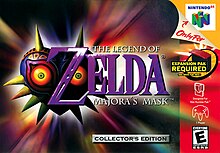
Back ذا ليجند أوف زيلدا: ماجوراز ماسك Arabic ث ليجيند اوف زيلدا: ماچوراس ماسك ARZ The Legend of Zelda: Majora’s Mask Byelorussian The Legend of Zelda: Majora's Mask Catalan The Legend of Zelda: Majora's Mask Danish The Legend of Zelda: Majora’s Mask German The Legend of Zelda: Majora's Mask Spanish The Legend of Zelda: Majora’s Mask Finnish The Legend of Zelda: Majora's Mask French The Legend of Zelda: Majora's Mask Galician
| The Legend of Zelda: Majora's Mask | |
|---|---|
 North American box art featuring the titular Majora's mask | |
| Developer(s) | Nintendo EAD |
| Publisher(s) | Nintendo |
| Director(s) | |
| Producer(s) | Shigeru Miyamoto |
| Programmer(s) |
|
| Artist(s) | |
| Writer(s) |
|
| Composer(s) | Koji Kondo |
| Series | The Legend of Zelda |
| Platform(s) | |
| Release | |
| Genre(s) | Action-adventure |
| Mode(s) | Single-player |
The Legend of Zelda: Majora's Mask[a] is a 2000 action-adventure game developed and published by Nintendo for the Nintendo 64. It was the second The Legend of Zelda game to use 3D graphics, following Ocarina of Time (1998). Designed by a creative team led by Eiji Aonuma, Yoshiaki Koizumi, and Shigeru Miyamoto, Majora's Mask was completed in less than two years. It features enhanced graphics and several gameplay changes, but reuses elements and character models from Ocarina of Time, which the game's creators called a creative decision made necessary by time constraints.
The story takes place months after Ocarina of Time. Link arrives in a parallel world, Termina, and becomes embroiled in a quest to prevent the moon from crashing in three days' time. The game introduces gameplay concepts revolving around a perpetually repeating three-day cycle and the use of various masks that transform Link into different forms. As the player progresses through the game, Link learns to play numerous melodies on his ocarina, which allow him to control the flow of time, open hidden passages, or manipulate the environment. Characteristic of the Zelda series, completion of the game involves successfully navigating through several dungeons that contain complex puzzles and enemies. Majora's Mask requires the Expansion Pak add-on for the Nintendo 64, which provides additional memory for more refined graphics and greater capacity in generating on-screen characters.
Majora's Mask earned universal acclaim from critics and is widely considered one of the best video games ever made. It received praise for its level design, story, and surrealist art direction, and has been noted for its darker tone and themes compared to other Nintendo titles.[1] While the game only sold about half as many copies as its predecessor, it generated a substantial cult following.[2][3] The game was rereleased as part of The Legend of Zelda: Collector's Edition for the GameCube in 2003, and for the online services of the Wii, Wii U, and Nintendo Switch. An enhanced remake for the Nintendo 3DS, The Legend of Zelda: Majora's Mask 3D, was released in 2015.
Cite error: There are <ref group=lower-alpha> tags or {{efn}} templates on this page, but the references will not show without a {{reflist|group=lower-alpha}} template or {{notelist}} template (see the help page).
- ^ Robinson, Nikole (April 15, 2023). "The Legend of Zelda: Majora's Mask: Inside the Surrealist Sequel That Was Never Supposed to Exist". GamesRadar+. Archived from the original on November 3, 2023. Retrieved January 26, 2024.
- ^ MacDonald, Keza (November 6, 2014). "Why The Legend of Zelda: Majora's Mask Still Matters". Kotaku. Archived from the original on October 30, 2023. Retrieved January 26, 2024.
- ^ Mejia, Ozzie (November 12, 2014). "The Legend of Zelda: Majora's Mask - Explaining Its Cult Following". Shacknews. Archived from the original on October 30, 2023. Retrieved January 26, 2024.